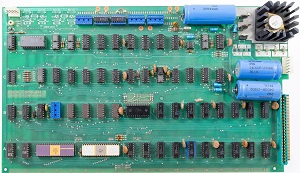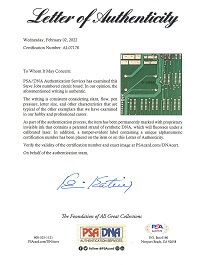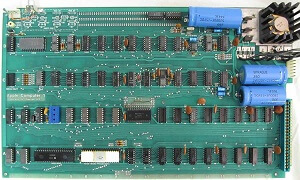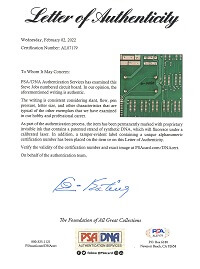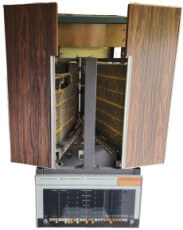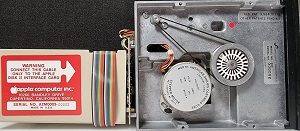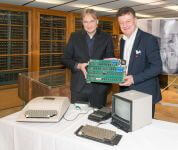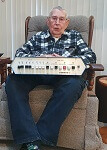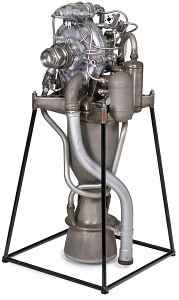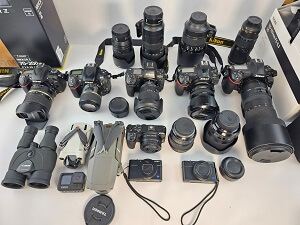Private website of Achim Baqué
This private website was created to introduce myself to like-minded individuals and, hopefully, foster new and interesting connections. It is entirely ad-free, does not use cookies, does not track visitors, and is hosted within the European Union.
Apple-1 Registry
Mike Willegal originally created the Apple-1 Registry, a comprehensive, non-profit list of all known Apple-1 computers. In early 2018, Mike entrusted the Apple-1 Registry to Achim Baqué.
The registry serves as an invaluable resource for owners, collectors, Apple fans, auction houses, and the media. The Apple-1 is not just a computer; it is an iconic and extremely rare piece of technology history. The purpose of the Apple-1 Registry is to preserve detailed information about each machine, including its history, current location, and condition. This effort is important because much of the original information about surviving Apple-1 computers has already been lost over time.
My original Apple-1 computers
My website, The Apple-1, is dedicated to my original, fully functional Apple-1 computers. It features detailed information, pictures, and videos. The iconic Apple-1, introduced in 1976, was the very first computer offered by Apple in the year of its founding.
In 2018, I added three more original Apple-1 computers to my collection, followed by another in early 2019. And I couldn’t stop there. The latest addition joined my collection in 2023.
I now own several original Apple-1 computers. If you are interested in selling an Apple-1 or related items, feel free to contact me anytime. Simply send a message with pictures, and we can discuss it further. Rest assured, all messages and photos will be treated with complete confidentiality.
Visit my website about my Apple-1 computers.
A list of exhibitions featuring my Apple-1 computers can be found here.
After years of research, I commissioned two forensic analyses in December 2021 to examine the handwritten serial numbers on original Apple-1 computers. The groundbreaking results came in January 2022: the serial numbers were personally written by Steve Jobs.
Unveiling who wrote the serial number on some of the first Apple-1 computers
On February 10, 2022, I had the honor of publishing the results of two forensic examinations of the handwritten serial numbers on several original Apple-1 computers from the first batch. The findings confirmed that the handwriting is indeed Steve Jobs'. Another lasting legacy of Steve Jobs. The story is here.
PSA provided a certificate of authenticity. It is even possible to validate the authentication online.Classic Computer Museum
My collection includes hundreds of vintage computers, along with many other vintage items such as hard drives, software, manuals, and more. Some items are extremely rare.
The main focus of my collection is on items from before 1984. It is dedicated to the preservation of historically significant computers and related artifacts.
Some are very rare. Like my Apple-1, some Apple II Rev. 0 (including two ventless), the one and only prototype Kenbak-1 (the first ever commercially available personal computer), some Apple Lisa 1,
Commodore C65, some Datapoint 2200, three Q1 computers, a Micral S, a DEC Straight-8, many Altair and IMSAI, various PDPs and
Mark-8,
JOLT,
Ontel OP-1,
RGS-008,
Intel Intellec 4 and 8 and Prompt 48, SwTPC 6800 and 6809, IBM 5100, IBM 5120, AIM-65, KIM-1, SYM-1 and VIM-1, Compukit UK-101, SIM8-01, NRI-832, Cogar System 4, Intel MCS-85, Cosmac ELF, RCA Super ELF, Programma 101 and 203, HP-9810/9825/9830/9835 etc., IASIS IA-7301, Olivetti P6060, Northstar Horizon, Polymorphic 8813, Micro-68, Science of Cambridge MK-14, NASCOM 1 and 2, SuperJOLT, Vector-1, Byt-8, DPS-1, OS Model 600, Signetics Instructor 50, IMSAI 8048, IMSAI PCS 80, Intel SDK-85, MMD-1, Compucolor II, DAI and so many more.
In 2021, a new fantastic object came into my computer collection: Apple Disk Drive S/N 2. The case AND the Shugart disk drive both have serial number 2. Both were bought directly from the famous Wendell Sander. Thanks, Wendell!
2024 and 2025 were by far the best years in terms of collecting vintage computers. There were countless new acquisitions, including many items I never thought I would find—such as a DEC Straight-8, a Mark-8 (bought directly from the builder), a JOLT (finally—one of the hardest computers to find), an Ontel OP-1 (I don’t know of any other owner), an RGS-008A (I am aware of only two in the world—the not-so-nice one in the CHM and mine), many WANG 2200, WANG 600, WANG 700A, HP 9100A, Anita MK VIII, and much more.
Pascal was the first programming language I learned, and it remains my favorite to this day. Its inventor, Niklaus Wirth, together with his team, created the magnificent Lilith computer in the late 1970s, early 1980s. This remarkable machine featured a graphical user interface and a mouse, long before such things became commonplace. I am fortunate to have the very first edition of the Lilith in my collection. The design was heavily inspired by the Xerox Alto, just as the Apple Lisa, Macintosh, and Windows would later be.
In 2025, I got in touch with the son of the developer of the 1-Bit-Computer, Kai Ludwig, and we hit it off right away. He gave me one of these handmade and extremely rare computers. We are planning to realize some projects together.
Btw, I own some IBM mainframe front panels/consoles—for example, the IBM 360/30, IBM 360/40, IBM 360/50, and the mighty IBM 360/75. Hopefully, one day I can also find the even bigger IBM 360/90, IBM 360/91, IBM 360/95, IBM 360/195, IBM 360/155, and IBM 370/195.
For 39 years I held onto the dream of one day owning a CRAY-1. What once seemed impossible finally became reality in August 2025, when an original CRAY-1 entered my collection. As one of the most iconic and sought-after supercomputers in history, its arrival marks a milestone that every dedicated collector will instantly recognize and understand.
There are also discussions with some people about other very rare computers. Some computers have already been promised to me by their current owners—it will just take some time until the deals are finalized.
So far, I haven’t had time to bring a dedicated website about my vintage computer collection online, but I am working on it.
My websites for the Apple-1s and the prototype Kenbak-1 are already available.
A few pictures of my vintage computers are here.
Hard Disk Drives
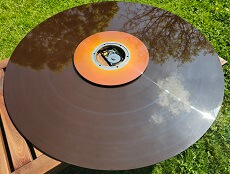 +
Bryant 39" and a 14" + 3.5"
+
Bryant 39" and a 14" + 3.5"
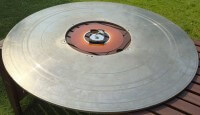 +
Librascope 48" hard disk from 1965 (largest in the world)
+
Librascope 48" hard disk from 1965 (largest in the world)
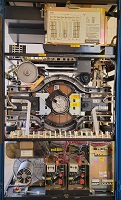 +
Complete IBM 3380 AD/AE
+
Complete IBM 3380 AD/AE
In my collection are countless hard disks from 0.8 inch up to 48 inch (yes, 48").
For more than forty years I have been collecting hard drives. In the beginning I focused on contemporary models, but from the 2010s onward my interest shifted to the large, historic systems. At first, finding a 14-inch disk felt extraordinary. Then came a 24-inch IBM RAMAC platter. The ultimate prize, however, was always the gigantic 39-inch Bryant hard disk platter, which finally entered my collection in 2021.
In 2025 I traveled to Salt Lake City and Provo and spoke with four pioneers, each with remarkable stories to share. One afternoon we sat for hours in a garden, listening to fascinating tales from the dawn of computing. At some point I mentioned my hard disk collection. We went down to the basement, and there it was, a 48-inch hard disk platter that is now also part of my collection.
The Librascope Disk File 48-inch hard disk is the largest ever made. For me, it is one of the crown jewels of my collection, truly the Mother of all Hard Disks.
The 48-inch platter measures 47.5 x 0.46 inches (120.65 x 1.16 cm) and weighs about 100 lbs (45 kg). Each Librascope L-1500 drive contained six platters, giving roughly 18.3 MB per platter and a total capacity of 110 MB.
Only four or five are known to survive worldwide. The other known 48 inch disk platters are owned by Stanford University, Computer History Museum and scientist Lester Earnest (as a coffee table).
I also own some CDC 31-inch hard disk platters. One of the greatest new additions was a complete, massive IBM 3380 AD/AE with two IBM 3380 E drives inside.
CRAY-1 s/n 53
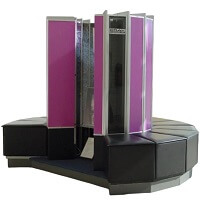 +
My CRAY-1S (more pics later!)
+
My CRAY-1S (more pics later!)
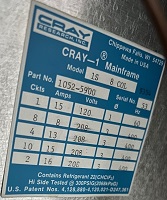 +
CRAY-1S s/n 53
+
CRAY-1S s/n 53
 +
CRAY-1S s/n 53
+
CRAY-1S s/n 53
 +
CRAY-1S s/n 53
+
CRAY-1S s/n 53
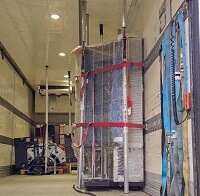 +
Arrival of my CRAY-1S s/n 53
+
Arrival of my CRAY-1S s/n 53
 +
Arrival of my CRAY-1S s/n 53
+
Arrival of my CRAY-1S s/n 53
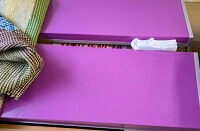 +
Arrival of my CRAY-1S s/n 53
+
Arrival of my CRAY-1S s/n 53
 +
Arrival of my CRAY-1S s/n 53
+
Arrival of my CRAY-1S s/n 53
Just hearing the name CRAY-1 is enough to give computing history enthusiasts goosebumps.
In August 2025, a lifelong dream finally became reality: I acquired an original CRAY-1, specifically a CRAY-1S. For several years, I had been in contact with representatives of a museum in Finland as well as collectors from across Scandinavia. At one point, I was even given a virtual tour of the museum, and there it was, a CRAY-1.
By 2024, the possibility of a purchase started to take shape. It no longer seemed entirely out of reach. In early July 2025, I flew to Finland to visit the museum in person and take a closer look at the machine. Beyond the technical fascination, it was a real pleasure to connect with fellow enthusiasts who share the same passion.
On August 18, 2025, we reached an agreement during our very first negotiation meeting. We talked for an hour, but the actual price negotiation took less than two minutes.
I still vividly remember talking about the CRAY-1 with my business partner in the 1980s. Its iconic design, historical significance, remarkable engineering, and legendary status made it completely irresistible. Back then only 17 years old, I said, "One day, I want to own a CRAY-1". It was the kind of thing a teenager might say, but for me, that dream never faded.
What were the chances that it would ever actually happen? Thirty-nine years later, it did.
This is my first supercomputer, and I’m honored to own the first masterpiece of the genius Seymour Cray.
Quite a few people laughed when I searched for a CRAY-1 publicly, but that also happened when I publicly expressed my desire for an original Apple-1 in 2015. The last laugh is on me. Only a few people have ever owned or currently own a CRAY-1.
The next step was finding Cray-1 boards to fill the cylinders and columns. Once again, everyone told me it would be nearly impossible and that I would have to buy them one by one at auctions.
It took some time, but I eventually managed to purchase 30 boards from one person and later, thanks to Tony Cole, another 150. With 180 boards in total (and many under Lucite), I now have enough to fill two columns and still have some left over for a large display of 36 boards arranged side by side.
At last, the Cray-1S arrived on September 25, 2025 — just three days before what would have been Seymour Cray’s 100th birthday.
When it comes to special vintage computers, I always invest a great deal of time researching the history of that specific machine. Who was the first owner? What was it used for? Who were the subsequent owners? For my Cray-1S, I gathered everything the Finnish museum knew, and I also contacted the university in Finland, the first owner Royal Shell in the Netherlands, HPE/Cray, and the museum in Chippewa Falls.
In my initial outreach, both Shell and HPE/Cray showed very little interest in researching their archives or offering assistance. This was surprising, especially considering that Shell had once invested heavily in public relations around the fact that it was using a Cray supercomputer. Their archives should be full of material that could help preserve the story of this milestone in computing and in Shell’s research. Instead, Shell and HPE/Cray referred me to their press offices, which usually means that no one actually wants to deal with the matter. I am convinced that Cray’s archives also hold a great deal of relevant material, unless it was discarded at some point. Unfortunately, not every company respects its own past or works to preserve its history.
Apple, for example, disposed of tons of early documentation some years ago. Fortunately, an employee informed Stanford University, which rescued the contents of those containers with Apple’s permissionand and archived important documents and items. A Stanford professor later granted me access to these materials.
The museum in Chippewa Falls offered to search and ask around. Fingers crossed.
In an article about my Cray, the name of an engineer was mentioned who had installed the Cray-1S at Royal Shell. I managed to track him down, and he still remembered that time very well. He kindly answered my countless questions as best he could.
Now I can only hope that I will still be able to obtain some information from the archives of Royal Shell and HPE/Cray.
Seymour Cray was a genius, a visionary, and a man of quiet demeanor. Many of the figures celebrated in IT today were little more than flamboyant showmen, repackaging the ideas of others as their own while contributing relatively little themselves. Seymour Cray, by contrast, was Cray Research. Its vision, its solutions, and its achievements were his. He was a true pioneer.
During his lifetime, Cray enjoyed an almost mythical reputation. He was referred to as “the Albert Einstein of supercomputing,” “the Thomas Edison of supercomputing,” and even “the Evel Knievel of supercomputing.” The admiration he commanded among engineers and professionals was boundless. When he spoke, the room would fall silent as everyone listened intently.
On one occasion, Cray delivered a lecture to programmers at the National Center for Atmospheric Research and invited questions afterward. No one raised a hand. When Cray left, the head of the center asked the programmers why no one had spoken up. One replied, “How do you talk to God?”.
Few individuals have ever inspired such reverence. Above all through genuine innovation and revolutionary ideas, not through eloquent speeches, staged and rehearsed appearances, or salesmanship.
Cray consistently made the impossible possible. The professional world doubted his visions—until they suddenly appeared, fully realized and functioning flawlessly. His supercomputers dominated the market for decades.
Seymour Cray deserves far greater recognition and appreciation for his profound contributions to the evolution of information technology.
Apple Disk Drive S/N 2
The story of Apple Disk Drive S/N 2 is truly fascinating. In early 1978, Wendell Sander was heavily involved in the engineering of the early Apple II boards. As part of this work, he focused on testing the Disk II controller card. Since the state machine PROM could not be accessed by the processor, Sander became intimately familiar with the state machine’s operation in order to develop an effective test sequence.
During this process, he discovered that Steve Wozniak, also known as 'Woz,' had miscalculated one of the timing paths by a single count. Sander reviewed the issue with Wozniak, who agreed with the correction, and Sander created updated PROMs to fix the error.
Around the same time, Apple was ramping up Disk II production. Although many drives were ready for shipment, they encountered a significant problem: the drives failed to meet the industry-standard error rate of 1 in 109, causing production delays. However, when Sander’s corrected PROMs were tested, the drives passed the error rate threshold, allowing Apple to begin shipping.
In recognition of his crucial contribution, Apple presented Sander with Disk Drive II S/N 2, which contained a Shugart floppy drive 390 S/N 2. Cliff Huston received Disk Drive II S/N 1, while Wozniak was given the Shugart 390 S/N 1.
I first saw this remarkable drive in 2018 during a visit with Wendell Sander. In December 2021, I had the privilege of acquiring this historic disk drive from him.
Research
Continuous research into the history of computers and challenging commonly accepted but unchecked information is important to me. With regard to the Apple-1, I have been able to gather a lot of new information over the years and get to the bottom of things. For example, the origin of the handwritten serial numbers on the Apple-1, the complete history of the so-called Byte Shop cases for the Apple-1, etc.
It’s amazing how false information keeps spreading on the Internet, and how rarely people conduct real research. In May 2025, I met with experts on Q1 computers at the Danish Computer Museum DDF and then visited the Heinz Nixdorf Museum. Everywhere I read that Nixdorf took over the Q1 Corporation in 1974. The Heinz Nixdorf Museum searched their archives, which list every takeover and acquisition—there was no such takeover. However, other sources mention a transfer of know-how from Q1 to Nixdorf, for which Nixdorf allegedly paid 10 × US$40,000.
Well, it could have been a deal with the U.S. branch of Nixdorf, but because of the nature of the reported know-how transfer, this seems very unlikely.
Sharing my passion for vintage computers
One of my original Apple-1 computers is on loan to the Deutsches Museum in Munich, Germany, where it is displayed for the public. The handover took place on 14 November 2017, with the Zuse 4 in the background. This is exactly where Steve Jobs personally handed over a Macintosh to the museum in 1985. It is on permanent display in the Microelectronics Department for the public.
I gave another Apple-1 for free to an art exhibition at the ZKM in Karlsruhe, Germany, from July 2018 to February 2019.
Additionally, I loaned another Apple-1 to an art exhibition at the ZKM in Karlsruhe, Germany, from July 2018 to February 2019.
In 2019, I traveled to the Bay Area in California with two of my original Apple-1 computers. Both were exhibited at the Computer History Museum in California, USA in Mountain View, California.
More information about exhibitions of my Apple-1 can be found here.
It would be nice to share more, and I am open to inquiries.
Wanted: vintage computer from the 60s, 70s and early 80s
If you have a vintage computer for sale or donation, please contact me. All messages and pictures will be handled confidentially. My mission is to preserve vintage computers, including related documents. Occasionally, rare items are loaned to museums. I also purchase complete collections.
In addition, I am actively seeking items related to space exploration, such as components from rockets, spacecraft, and NASA probes. I have a wish list.
I have shipping addresses in the USA, UK, France, and Germany.
John Blankenbaker's former website kenbak-1.net
John Blankenbaker was 92 years old when he stopped maintaining his website, which eventually went offline. I had been in contact with him for years and had the privilege of visiting him twice. Finally, he gave me permission to take over the website and preserve his legacy.
John wrote to me on March 4, 2022: "Yes, you may have the content. I used a .net designation. Perhaps you might want to convert to a .com or a .info designation."
John Blankenbaker's original kenbak-1.net website.
Note: His website is very old and static, making it unsuitable for mobile devices. Any changes were made with great care to preserve its original state as faithfully as possible. It now stands as a piece of history.
Kenbak-1 Registry
After taking care of John Blankenbaker’s former webpage to preserve his legacy and the history of the Kenbak-1, I decided to create a registry of the Kenbak-1. Someone should preserve it and follow the path of the few original Kenbak-1 units.
I also maintain the Apple-1 Registry. It is more effort and work than you can imagine, but the result is worth it.
Visit the Kenbak-1 Registry.
The direct contact and many conversations make me feel very connected to John. It was a twist of fate that he was ahead of his time. He even planned a successor with a CPU. But since the computer was only advertised in American Scientific, the commercial success was low. Who knows, maybe otherwise we would have been working with a 'Kenbak-X'?
It's amazing anyway that it wasn't Xerox that became the world's number one in computers, despite the incredible developments at Xerox PARC.
Space and Astronomy
From the age of seven, I was fascinated by astronomy and space flight.
As a teenager, I did an internship at the Max Planck Institute for Radio Astronomy in the 'mm' laboratories. They actually wanted to send me to Chile, where a new ESA telescope was being built. But there were delays.
Only through contact with computers did my focus shift. Nevertheless, I am still very interested in both topics.
I have many collection objects in my possession, including some artifacts from the terrific Apollo and Space Shuttle missions. A few years ago, I had the chance to buy the mighty Kholod Rocket. The owner contacted me, but where to put such a gigantic piece? It would have been very conspicuous on private property, and the neighbors certainly wouldn't have liked it. Now I'm hoping to find smaller rockets or jet engines that I like.
Photo / Video
After the first 10 years, about 100k pictures and footage were sold, and my collection grew to several thousand time-lapse videos and millions of pictures totaling 100+ TB.
In the early years of stock photography, so-called macrostock was a big market. Later, it changed, and now only a tiny fraction of my portfolio is listed at some microstock agencies.
Many of my time-lapse videos are shown on TV, in motion pictures, video productions, commercials, and on websites.
Pictures are used for many purposes like websites, books, magazines, advertisements, etc.
Some examples of my work
Footage: pond5 shutterstockStock photography: shutterstock adobe stock / fotolia
Time-lapse
Time-lapse is fascinating. Endless creativity and possibilities for the photographer.
It started as a hobby. Many years ago, there were not many tools to produce time-lapse videos. Today, many cameras support time-lapse photography and endless tools are available. Nowadays, it is easy to find all information on the Internet, and many mobile phones have a time-lapse function.
When I started time-lapse photography, I had to research everything myself. Experimenting was necessary.
Traveling - the spirit of life
To travel is the best way to broaden your horizon, to see and understand different lifestyles, how to look at life, etc.
It changes your life. You meet people who grew up in different societies and under different circumstances. It teaches you tolerance, greatly increasing your knowledge and understanding of people, countries, and the world.
My girlfriend and I want to see as much of the world as possible, but not at any price. Many countries are not a destination for us because of wars, unrest, or security problems.
About me
 My name is Achim Harald Baqué.
My name is Achim Harald Baqué.
I was born in 1968 in former Western Germany, where I live and work most of the time.
Openness
Why do I share so many private things here when most people try to remain anonymous on the Internet? I often connect with like-minded people and those who have a similar background. Especially when it comes to collecting computers, it’s helpful not to be anonymous. Who would contact a 'user123' to negotiate the sale of a rare computer? If you would like to contact me and find out who you are dealing with, here is some information about myself:
Early years
Astronomy and particle physics were passions of mine during my youth, and I was 100% sure this would be my career as an adult. My focus was on elementary particle physics. I bought my first book about astronomy at the age of 7. Later, I spent a lot of time with a soldering iron. Electronics was fascinating. At school, my favorite subjects were physics, chemistry, and mathematics. Later in high school, computer science.
Fields of interest
Traveling, photography, time-lapse videography, diving, drones, vintage computers, programming, electronics, space, stock market, fast cars, and convertibles. In my early years: chemistry, physics, elementary particle physics, mathematics, astronomy, space.
I'm absolutely not nostalgic, just someone who loves history. Growing up in the present time or in the future would be fantastic. I would not want to live in the past.
The possibilities today are unimaginably greater than in the last century—in all aspects: technology, food, travel, access to information, etc.
A few pictures
Some pictures of vintage computung.
Some travel / private pictures.


